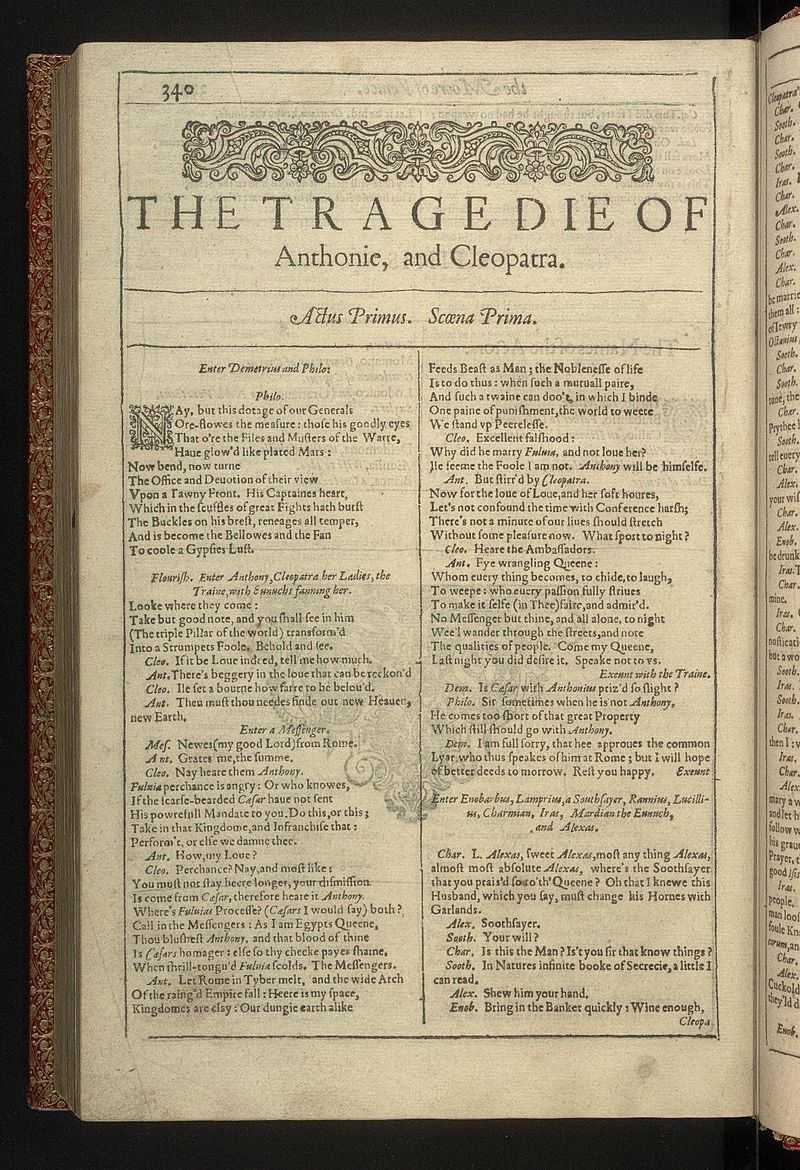Antony and Cleopatra
Antony and Cleopatra is a tragedy by William Shakespeare. The play was performed first circa 1607 at the Blackfriars Theatre or the Globe Theatre by the King's Men. Its first appearance in print was in the Folio of 1623.
The plot is based on Thomas North's translation of Plutarch's Lives and follows the relationship between Cleopatra and Mark Antony from the time of the Sicilian revolt to Cleopatra's suicide during the Final War of the Roman Republic. The major antagonist is Octavius Caesar, one of Antony's fellow triumvirs of the Second Triumvirate and the first emperor of the Roman Empire. The tragedy is mainly set in Rome and Egypt and is characterized by swift shifts in geographical location and linguistic register as it alternates between sensual, imaginative Alexandria and a more pragmatic, austere Rome.
Many consider Shakespeare's Cleopatra, whom Enobarbus describes as having "infinite variety", as one of the most complex and fully developed female characters in the playwright's body of work. She is frequently vain and histrionic enough to provoke an audience almost to scorn; at the same time, Shakespeare invests her and Antony with tragic grandeur. These contradictory features have led to famously divided critical responses. It is difficult to classify Antony and Cleopatra as belonging to a single genre. It can be described as a history play (though it does not completely adhere to historical accounts), as a tragedy (though not completely in Aristotelian terms), as a comedy, as a romance, and according to some critics, such as McCarter, a problem play. All that can be said with certainty is that it is a Roman play, and perhaps even a sequel to another of Shakespeare's tragedies, Julius Caesar.

Date and text
Many scholars believe it was written in 1606–07, although some researchers have argued for an earlier dating, around 1603–04. Antony and Cleopatra was entered in the Stationers' Register (an early form of copyright for printed works) in May 1608, but it does not seem to have been actually printed until the publication of the First Folio in 1623. The Folio is, therefore, the only authoritative text we have today. Some scholars speculate that it derives from Shakespeare's own draft, or "foul papers", since it contains minor errors in speech labels and stage directions that are thought to be characteristic of the author in the process of composition.
Modern editions divide the play into a conventional five-act structure, but as in most of his earlier plays, Shakespeare did not create these act divisions. His play is articulated in forty separate "scenes", more than he used for any other play. Even the word "scenes" may be inappropriate as a description, as the scene changes are often very fluid, almost montage-like. The large number of scenes is necessary because the action frequently switches between Alexandria, Italy, Messina in Sicily, Syria, Athens, and other parts of Egypt and the Roman Republic. The play contains thirty-four speaking characters, fairly typical for a Shakespeare play on such an epic scale.












0 comments
Sign in or create a free account